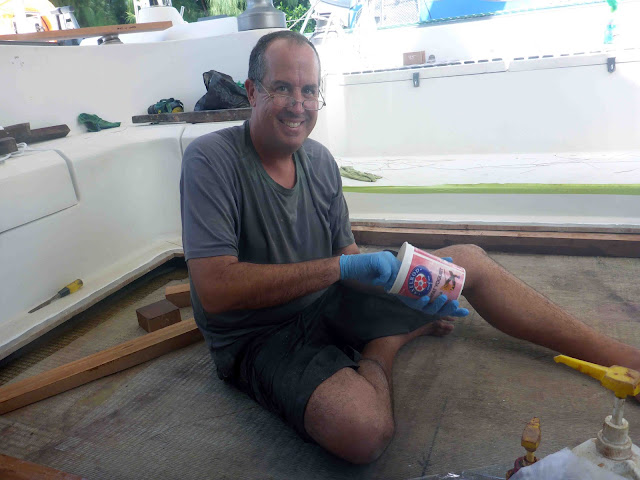 |
| by Pel Laurens |
Everyone knows what happens when you assume. Apparently, we have not learned this lesson well enough.
Remember that rudder post I was whining about? (We need a 39 mm rudder post and no one makes them, blah blah blah.) Well, as it turns out, the post is actually 40 mm, which is a standard size.
Why did we think it was 39 mm? We assumed that the two rudders were the same (because on a catamaran there would be no reason to make them different, right?). Our starboard rudder, which is the one that had the issue, was off site, hopefully to be worked on. So we measured the port rudder, which does measure 39 mm.
When it was clear that it might be awhile before we could order a new stainless steel rod, we retrieved the starboard rudder and blade from the foundry. But we still didn't bother to check the diameter. When you need new tires for your car, do you bother to look at the sizes of each tire?
We were still working hard on getting a 39 mm shaft and found a local place that might be able to machine one for us, when we discovered that we would need 2 rudder shafts. All our work trying to hunt down the elusive 39 mm rod made us double-check the integrity of the port rudder shaft. We found some corrosion on it, which though not as bad as the corrosion on the starboard side, is enough to make us replace it as well.
After we returned from Singapore, Matt got busy opening up the port rudder blade. The fiberglass did not come apart quite as easily as it did on the starboard side and we thought it might be because water had gotten into the starboard blade and rotted away some of the foam, making it easier to pull apart.
 |
| The guts of the port rudder blade |
Instead, as it turns out, the port blade (probably the one original to the boat), was of a totally different construction. Instead of the softer foam filling found in the starboard side, it is constructed with a light material with the hardness of concrete. Once we saw that the construction was different, a light bulb finally went on and we realized that we better check all the measurements to make sure we knew what we were dealing with. Sure enough the rudder stock diameter and bearings were different sizes. At some point, the starboard rudder must have been rebuilt using a 40 mm rod, while the port rudder had the original 39 mm rod.
 |
| Chipping off the old blocks |
 |
| Major excavation needed. It is solid construction with no water inside. It's a shame it has to be redone. |
 |
| The internal structure of the rod supports in this port rudder is completely different from the starboard. |
 |
| The starboard side, for reference |
So, where does that leave us? For one, feeling really lucky that we didn't spend a bunch of money on a 39 mm rod (and that we didn't order 2, which is the path we were on). We will probably get 2 40 mm rods, hopefully at a more reasonable cost. The 40 mm will fit into the channel in the starboard rudder blade and the port rudder blade won't have a channel (Matt will build a jig to ensure that the placement of the shaft into the blade is correct). The bearings on the port side will have to be enlarged. All-in-all, it probably adds on at least another 2-3 (to 4, to 5) weeks that we are out of the water.





















































